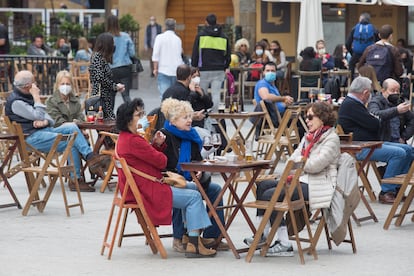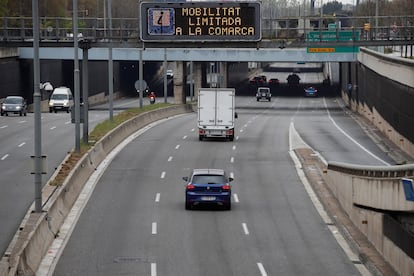As fourth coronavirus wave gains pace in Spain, experts call for tougher restrictions from regions
The more-infectious variant first detected in the United Kingdom now accounts for 90% of new infections in some areas, while the incidence rate across the country is approaching an extreme-risk level


The fourth wave of the coronavirus pandemic is advancing in Spain. While it is moving at different speeds from region to region, the curve of infections is growing in nearly all of the country’s territories – apart from in the Balearic Islands – and the 14-day cumulative number of coronavirus cases per 100,000 inhabitants now stands at 199, according to the latest Health Ministry report, which was released on Monday. This key data point has risen 21.8% in a week.
Pressure on Spanish hospitals is also rising once more, with more than 10,200 Covid-19 patients currently receiving treatment. What’s more, one in five intensive care unit (ICU) beds is occupied by a coronavirus patient, accounting for a total of 2,161 people. The Health Ministry report also added 197 deaths to the official toll, which now stands at 76,525.
The Madrid region currently has a 14-day cumulative number of coronavirus cases per 100,000 inhabitants of 336, but yet has not introduced any tougher measures for restaurants or bars
Most of the country’s regions – which are in charge of the local measures to deal with the epidemic – are combatting this new spike in cases with perimetral lockdowns and social restrictions, but this new rise in the epidemiological curve has once again raised questions about the lax measures. For example, the Madrid region currently has a 14-day cumulative number of coronavirus cases per 100,000 inhabitants of 336, but yet has not introduced any tougher measures for restaurants or bars. This is in spite of the Health Ministry’s recommendations that the interior of such establishments should be closed when this indicator exceeds the 150-mark. The experts consulted by EL PAÍS are emphatic: stricter measures are needed.
One element that is making it harder to control the spread of the coronavirus, and that requires more restrictions, is the presence of the more contagious strain that was first detected in the United Kingdom. This variant is now predominant in Spain and accounts for between 60% and 90% of infections, depending on the region. Daniel López-Acuña, a former director of emergencies at the World Health Organization (WHO), warns that due to this strain “the speed of contagions and saturation of hospitals will rise.” The variant has been circulating in Spain for months and is also predominant in the UK, where tough restrictions have been in place for months to control its spread.
In its report, the Health Ministry details that there are other variants circulating in Spain – the one identified in South Africa, two from Brazil and another from California – but that the British strain has been dominant for more than a month. It is more contagious, according to the ministry, but has a “low effect on immunity” with a “small reduction in the effectiveness of the vaccine.”
According to the Health Ministry’s alert system, 11 regions have registered an incidence above the high or very high risk level, which starts at 150 cases per 100,000 inhabitants
The curve of infections is going up faster in Andalusia, Aragón and Castilla-La Mancha, where it has grown more than 40% in a week; while in Castilla y León, the 14-day cumulative number of coronavirus cases per 100,000 inhabitants has reached 196, which is 27% up on the previous Monday. Meanwhile, Madrid, Navarre, Cantabria, the Basque Country and La Rioja have seen the incidence rise by about 20%. In the remaining Spanish regions, the rise is slower.
Physicist Clara Prats, who is an expert in computational models of infectious diseases and a member of the BIOCOM-SC computational biology and complex systems group at Catalonia’s Polytechnic University, explains that “it is normal for there to be different velocities, because they depend on the measures in place in each area, how people are sticking to those restrictions, the history of each place and its level of natural immunity, the way that people interact…”

According to the Health Ministry’s alert system, 11 regions have registered an incidence above the high or very high risk level, which starts at 150 cases per 100,000 inhabitants.
The situation looks like it is going to get worse, at least over the coming days. The effect of the Easter vacation, when there were greater mobility and social interaction, is now starting to be registered in the epidemiological curve. This week and the next will be key to determining the dimensions of the first wave.
Fernando Simón, the director of the Health Ministry’s Coordination Center for Health Alerts (CCAES), said on Monday that “we are now seeing the transmission that took place in Easter week. We can’t stop what has already happened. But we can stop what will come from here onward. We can avoid reaching 300 cases per 100,000 [inhabitants]. The measures that the regions have put in place and vaccination will help us to control the epidemic.”
Easter restrictions
In order to curb the spread of the coronavirus, the majority of the country’s regions have opted to keep the social restrictions that were agreed for Easter week in place, such as the perimetral lockdowns (only the Madrid region and the Balearic and Canary islands have reopened for now). The nighttime curfew – starting at 10 or 11pm, depending on the region – and the limitations on social meetings have also been kept in place in all regions, but the rest of the restrictions vary from place to place, even on a municipal level.
But the areas that are being worst hit by this fourth wave are not necessarily the ones that are taking the strictest measures. While Madrid has opted for very lax restrictions, the Valencia region – which was particularly hard hit during the third wave – is sticking with the tough limitations, despite having the lowest incidence in Spain (36.34): the capacity of bars is limited to 30% inside and they must close at 6pm (in Madrid, the capacity is 50% and they shut at 11pm).
“The root of the problem came before Easter week,” López-Acuña explains. “They were minimal measures that should have been ramped up as the incidence increased. We were too confident that the perimetral lockdowns and curfew were going to help us. These two measures can bring contagions down by 50%, but the rest depends on what happens within those perimeters. A more restrictive attitude is needed in the inside of bars and in terms of the capacity of gyms and shopping malls.”
Some regions have toughened up the restrictions given the rise in infections: Catalonia, with 227 cases per 100,000 inhabitants, has locked down its comarcas – a traditional administrative division in the territory. In Cantabria, with an incidence of 161, bars and restaurants have had to close their indoor areas. In Castilla y León, bars and restaurants have been closed in a number of cities, such as Salamanca.
“The measures need to be more aggressive,” says Jesús Molina Cabrillana, an epidemiologist from the Spanish Society of Preventive Medicine, Public Health and Hygiene. “As well as limiting mobility, the key is to close the interior of bars.” Juan Pablo Horcajada, the head of infectious diseases at the Mar de Barcelona Hospital, agrees: “To avoid disaster, we have to increase social distancing. The virus still has a lot of gasoline left, with which it can burn millions of people.”
English version by Simon Hunter.
Tu suscripción se está usando en otro dispositivo
¿Quieres añadir otro usuario a tu suscripción?
Si continúas leyendo en este dispositivo, no se podrá leer en el otro.
FlechaTu suscripción se está usando en otro dispositivo y solo puedes acceder a EL PAÍS desde un dispositivo a la vez.
Si quieres compartir tu cuenta, cambia tu suscripción a la modalidad Premium, así podrás añadir otro usuario. Cada uno accederá con su propia cuenta de email, lo que os permitirá personalizar vuestra experiencia en EL PAÍS.
¿Tienes una suscripción de empresa? Accede aquí para contratar más cuentas.
En el caso de no saber quién está usando tu cuenta, te recomendamos cambiar tu contraseña aquí.
Si decides continuar compartiendo tu cuenta, este mensaje se mostrará en tu dispositivo y en el de la otra persona que está usando tu cuenta de forma indefinida, afectando a tu experiencia de lectura. Puedes consultar aquí los términos y condiciones de la suscripción digital.
More information
Últimas noticias
Most viewed
- Reinhard Genzel, Nobel laureate in physics: ‘One-minute videos will never give you the truth’
- Oona Chaplin: ‘I told James Cameron that I was living in a treehouse and starting a permaculture project with a friend’
- Pablo Escobar’s hippos: A serious environmental problem, 40 years on
- Why we lost the habit of sleeping in two segments and how that changed our sense of time
- Chevy Chase, the beloved comedian who was a monster off camera: ‘Not everyone hated him, just the people who’ve worked with him’









































